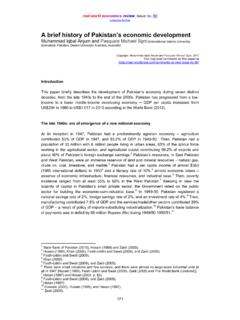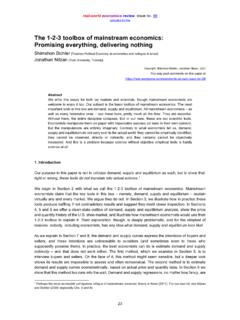Transcription of Externalities, public goods, and infectious diseases
1 Real-world economics review, issue no. 99 subscribe for free 25 Externalities, public goods, and infectious diseases Spencer Graves [Founder, , Kansas City, Missouri USA] Douglas Samuelson [President and Chief Scientist, InfoLogix, Inc., Annandale, Virginia USA] Copyright: Spencer Graves and Douglas Samuelson, 2022 You may post comments on this paper at Abstract COVID-19 has been mutating so fast that existing political and economic systems may not be able to control it without (a) getting many more people vaccinated and complying with other public health measures like masks, and (b) more effective vaccines than currently available. This article discusses externalities and other economic phenomena associated with managing infectious diseases . The history of COVID-19 suggests that a better understanding of these issues might help economists make better contributions to improving the effectiveness of public health measures for this and other infectious diseases .
2 It also suggests that urgent action can help save lives and improve the international economy. The economic question for public health is to design public policy to minimize the present value of the burden of disease in perpetuity at some reasonable discount rate. This has implications for (i) pricing of tests, treatments, vaccines and other risk-reduction protocols and (ii) public health monitoring, especially for infectious diseases like influenza and future novel diseases like COVID-19, which experts claim are becoming more frequent as humans increasingly interact with ecologies that have traditionally been more isolated. It also raises questions about whether it might be wise to separate new product development in these areas from testing and production. Also, to help communicate the need for compliance with public health measures, society might require everyone who travels to carry liability insurance to cover losses suffered by others directly or indirectly infected from The urgency of faster spreading variants of COVID-19 Before discussing economic considerations of infectious diseases , we feel a need to first summarize the urgency that we perceive in the spread of COVID-19 as we are writing this: The speed with which faster spreading variants of COVID-19 have been appearing suggests that humanity may not be able to control this disease without moving much faster to (a) get an effective vaccine to anyone any place in the world willing to be vaccinated, and (b) convince more anti-vaxxers2 and anti-maskers3 to do their part to protect others whom they will likely infect if they get this disease.
3 1 Parts of this work are available in Wikiversity "Externalities, contagious diseases , and news" ( ,_contagious_diseases_and_news); accessed 30 August 2021. 2 See the discussion of vaccine hesitancy below, esp. incl. "liability insurance for contagious diseases ". 3 References on "Mask refusal" are discussed in the Wikipedia article with that title, accessed 19 September 2021. real-world economics review, issue no. 99 subscribe for free 26 Even that may not be enough without more effective countermeasures than what we have right now, according to data summarized in Figure 1, which plots the "Basic reproduction number,"4 R0, for the original Wuhan variant, along with the variant that took Europe by storm in early-to-mid 2020 and the Alpha and Delta variants, along with estimates of the uncertainties. As this is being written, the most virulent, deadly, and least understood variant is Its basic reproduction number has been estimated at between 5 and If it's 8, that means that we will need percent (= 1-1/8) of humanity immune or otherwise protected from exposure to this disease to stop the number of new cases from growing.
4 That's the "Herd Immunity Threshold" axis on the right hand side of Figure It will not be enough to get percent of humanity vaccinated with the current vaccines, because no vaccine is perfect. If 100 percent of humanity were newly vaccinated with a vaccine that is 90 percent effective, we would be just barely above that percent figure. The Pfizer and Moderna vaccines were reportedly 90 percent effective a month after the second More recent research "found that the efficacy of the Pfizer-BioNTech vaccine against hospitalization fell from 91 percent to 77 percent after a four-month period following the second shot. The Moderna vaccine showed no decline over the same period."9 But it's worse than that, because a new variant worse than Delta could already be circulating, but scientists have not yet collected enough data to identify it as such; this is indicated by the red question marks (?) near the upper right of Figure 1.
5 The risk of worse variants is proportional to the total number of cases. That's why it's so urgent to get as many people as possible vaccinated and complying with other public health protocols like masking. This is not a minority position. Two-thirds of the epidemiologists surveyed in March 2021 thought that ZH KDG D \HDU RU OHVV EHIRUH WKH YLUXV PXWDWHV WR WKH H[WHQW WKDW WKH PDMRULW\ RI ILUVW-generation vaccines are rendered ineffective and new or modifieG YDFFLQHV DUH UHTXLUHG. 10 Harvey et al. (2021) are 4 The "Basic reproduction number" "is the expected number of cases directly generated by one case in a population where all individuals are susceptible", according to the Wikipedia article with that title, accessed 19 September 2021. This concept has been used routinely in epidemiology since 1952. It is, however, quite difficult to estimate, which explains the wide range of uncertainty in the estimates of R0 for the variants of COVID-19 considered in Figure 1.]
6 5 Since this was submitted for review but before it is being published, the Omicron variant has been identified as a major problem. However, we are unaware of any credible studies of its basic reproductive number. In addition, the primary concern in this analysis is the economics of infectious diseases . We are therefore not discussing Omicron extensively in this article. 6 Gallagher (2021). Liu and Rockl v (2021) "identified five studies, which estimated the basic reproductive number for Delta [ranging] from to 8, with a mean of " We could revise Figure 1 and Appendix 1 using this information. We will not do so here, because the changes would not alter the main point of this article, namely the importance of considering externalities, public goods, free riders and the commons in setting public policy for infectious diseases . For detailed planning regarding COVID-19, it might make sense to expand these analyses.
7 7 See Wikipedia on "Herd immunity" and references cited therein, accessed 19 September 2021. 8 Wikipedia on "COVID-19 vaccine " cites multiple sources giving different numbers for the efficacies of the different vaccines. This article cited sources saying, "In Phase III trials, several COVID-19 vaccines have demonstrated efficacy as high as 95% in preventing symptomatic COVID-19 infections." However, "real-world vaccine effectiveness (RWE)" is lower. A 6 May 2021 Tweet from @sputnikvaccine claimed 80 percent efficacy from one shot ( ), accessed 30 August 2021. See also Thompson et al. (2021) and Wikipedia on " vaccine efficacy", accessed 19 September 2021. 9 Mandavilli (2021). 10 Ellyatt (2021). real-world economics review, issue no. 99 subscribe for free 27 concerned about "immune escape": As strains develop that are resistant to a vaccine , they will increasingly threaten people who have already been vaccinated.
8 Figure 1. Fastest spreading variants of COVID-19 Note: The axis on the left is the basic reproduction number, R0, which is the number of people in a susceptible population infected by each infected individual. The axis on the right is the associated Herd Immunity Threshold = 1-1/R0 = the proportion of the population that must be immune to control the disease. The dashed lines indicate the published limits for the Wuhan, Alpha and Delta variants. For the Wuhan variant, this is a 95 percent confidence interval derived from a meta-analysis of other published studies. Our source for the Alpha and Delta limits did not state a confidence level; we assumed 95 percent. We also assumed that the estimates of R0 follow a lognormal distribution, which allows us to impute standard errors for the estimated values of log(R0) as , and for Wuhan, Alpha, and Delta, respectively. We use the latter number to estimate the uncertainty in the estimated R0 for the early phases of the pandemic in Europe.
9 "W" indicates the date of creation of the Wikipedia article for each variant, which is a measure of when it became "notable". Each such Wikipedia article contains references suggesting dates when the first case of that variant seems to have appeared, which we used for the start of each horizontal line segment. The question marks "?" on the plot indicate that new variant(s) may already be spreading faster than Delta but have not yet been identified as Harvey et al. (2021) claimed that between December 2019 and October 2020, the virus was "acquiring approximately two mutations per month in the global population."12 That's grossly misleading, because the mutation rate is not a function of time: It's proportional to the number of patients infected and spreading a COVID tends to linger longer and generate more mutations in patients whose 11 The numbers for this plot and references for them are summarized in Appendix 1.
10 This plot was initially prepared before the appearance of Omicron. It could be updated at any time that credible estimates of R0 for it are available. That's not a serious priority for the purposes of this paper, because the issue here is the general theory of the economics of infectious diseases , not restricted to COVID. 12 Harvey et al. (2021). 13 In living organisms, the error rates in copying DNA have been estimated at between 10-4 and 10-5 per base or "letter" in the DNA sequence. See Milo and Phillips (undated). However, many living organisms have mechanisms for finding and fixing errors. And many of the errors that don't get corrected cannot function. Of those that continue to function, only a few are more transmissible or more virulent (with either a higher risk of death or long-term disability). real-world economics review, issue no. 99 subscribe for free 28 natural defenses have been suppressed by drugs to fight cancer, manage autoimmune disorders like rheumatoid arthritis, or keep transplanted organs from being rejected, or who have untreated or poorly treated COVID reportedly underwent 32 genetic changes in 216 days (approximately seven months), in one HIV patient, averaging days between Another HIV patient generated 5 COVID mutations in 15 days, averaging 3 days between Shah (2022) insists that accurate analyses of the evolution of diseases like COVID should consider exchanges both to and from non-human hosts.









